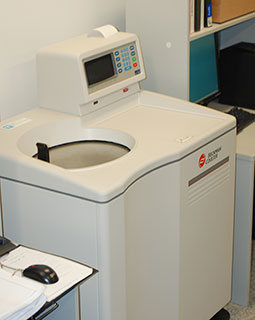Analytical Ultracentrifuge

Location: Level 1 South, Room 115
Models: 2 Beckman Coulter XL-I (UV absorbance and interference detection)
1 Beckman Coulter XL-A with Aviv Biomedical Fluorescence Detection System (FDS)
Analytical ultracentrifugation is a well-established technique for studying the behaviour of proteins in solution.
Experimentally determined sedimentation coefficients provide information regarding the size, shape, and interactions of macromolecules. Because the measurements are based on the first principles of thermodynamics and hydrodynamics, no standards or calibrations are required.
MIF instruments are capable of measuring sample absorbance in the UV-Vis range as well as fluorescence. The absorbance optics in the XL-Is have a wavelength detection range of 190 nm to 800 nm. The fluorescence optic has a single 488 nm excitation source, with detectable emission wavelengths above 505 nm.
We offer a service where the following are performed for users (for a fee):
- Loading of samples, setting up and running the experiment
- Cleaning of equipment after the experiment
- Data analysis and a preparation of a short report explaining the results
Types of experiments
Sedimentation Velocity experiments
- enable the determination of the sedimentation coefficient (including distribution of species in a heterogeneous sample), diffusion coefficient, frictional/axial ratio (i.e. shape), and rough estimates of molecular weight.
- Experiments generally require 380μl of sample and 400μl of reference (i.e. buffer blank)
- experiments are conducted at high angular velocities (e.g. 40,000 rpm) and data is collected at short time points (e.g. every 3-10 mins) for up to 6 hours.
Sedimentation Equilibrium experiments
- Enable accurate determination of the native molecular weight(s) of a sample, estimation of the binding affinity (i.e. KD) of self- and hetero-associating systems and stoichiometry.
- Experiments generally require 100μl of sample and 120μl of reference (i.e. buffer blank)
- Experiments are conducted at multiple low angular velocities (e.g. 10,000 rpm and 16,000 rpm) and data is collected every 2-4 hours and for up to 48 hours.
Resources
Experimental data analysis is performed using the programs SEDFIT and SEDPHAT, both written by Dr. Peter Schuck at NIH (USA). The software can be downloaded from Peter’s highly informative analytical ultracentrifugation website.
A highly-readable booklet on the theory behind AUC and things to look out for when doing AUC experiments: Beckman & Greg Ralston's 'Introduction to Analytical Ultracentrifugation' booklet. [PDF, 0.43 KB]